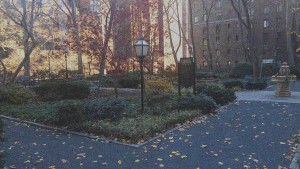Repent! The End (of the Art Bubble) is Nigh!
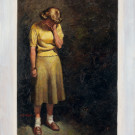
Laurence Fink, chairman of the world’s biggest asset management firm, Blackrock, said recently that contemporary art, along with apartments in places like New York and London, had supplanted gold as the world’s top store of value. This is an ominous signal for the art world.
The concept of “store of value” is one that acquires relevance in direct proportion to your wealth. That $1,000,000 you’ve put under your mattress will be worth only about $550,000 twenty years from now figuring 3% inflation. Buy a Manhattan apartment with the money (you can probably afford an okay studio), chances are you won’t take such a haircut. Invest in the next Apple and maybe you’ll do a lot better (invest in the next Enron, maybe you’ll end up with nada).
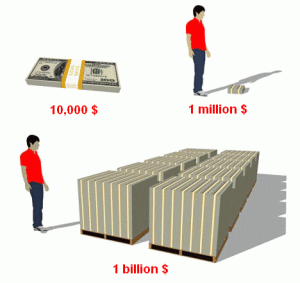 But let’s say you’re a billionaire. Forbes Magazine says that there are 1,826 such people in the world in 2015, and their problem is literally a thousand times worse than yours (a billion is a thousand million). How can you efficiently store immense wealth so that it remains safe and keeps its value? It won’t fit under the mattress. In fact it was this sort of dilemma that led to the invention of money, an abstraction that could be used to stand in for the actual wealth it represented, whether that wealth be land, goats or wives.
But let’s say you’re a billionaire. Forbes Magazine says that there are 1,826 such people in the world in 2015, and their problem is literally a thousand times worse than yours (a billion is a thousand million). How can you efficiently store immense wealth so that it remains safe and keeps its value? It won’t fit under the mattress. In fact it was this sort of dilemma that led to the invention of money, an abstraction that could be used to stand in for the actual wealth it represented, whether that wealth be land, goats or wives.
The only essential criterion for something to become money is that everyone agrees that it’s money. Over the centuries some abstractions that people have agreed can be money are shells, beads, axes, gigantic donut-shaped carved limestone wheels, woodpecker scalps, bitcoins and of course printed slips of paper bearing pictures of dead Presidents.
Gold is a particularly successful abstraction for money, though it has no real “intrinsic” value. You can get milk from a goat, you grow vegetables on land, and wives can demonstrate value in numerous ways, but gold just sits there, weighing a lot and not producing anything. But gold is a unique material that is easily worked into beautiful articles that don’t deteriorate over time. It is naturally rare. For millennia people have been willing to trade goats and wives for gold. You’d be betting against history if you thought that demand for it, whether rational or not, was suddenly going to evaporate.
Demand for other abstract stand-ins for wealth like woodpecker scalps (and paper money issued by profligate countries) is not so stable. Which brings us to art.
Art, like gold, doesn’t produce anything but can be beautiful to look at and its natural supply is limited. While many artists may toil at their craft the output of only a vanishingly small minority is ever transformed from mere decorations into a store of significant value.
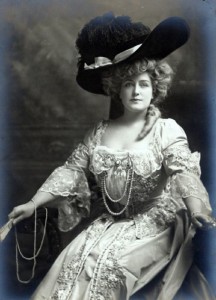 Exceptionally talented artists who worked for decades to hone their skills used to be the ones to whom cultures awarded fame and wealth. But starting in the late 19th century, artists began to achieve greatness because they broke the rules. Vincent Van Gogh never sold a painting in his entire life, but our culture came to consensus years ago that his work was revolutionary, a turning point in history. The Impressionists broke the rules, too. Though many of their contemporaries thought Impressionism was ridiculous, today we see paintings by Monet, Renoir and others as both valuable and beautiful. But both value and beauty are relative notions that change as societies change (Lillian Russell was considered one of the most beautiful women in the world in the 1890s; today she would be considered plus-sized). So do concepts of wealth.
Exceptionally talented artists who worked for decades to hone their skills used to be the ones to whom cultures awarded fame and wealth. But starting in the late 19th century, artists began to achieve greatness because they broke the rules. Vincent Van Gogh never sold a painting in his entire life, but our culture came to consensus years ago that his work was revolutionary, a turning point in history. The Impressionists broke the rules, too. Though many of their contemporaries thought Impressionism was ridiculous, today we see paintings by Monet, Renoir and others as both valuable and beautiful. But both value and beauty are relative notions that change as societies change (Lillian Russell was considered one of the most beautiful women in the world in the 1890s; today she would be considered plus-sized). So do concepts of wealth.
Take one of the most famous artworks in the world: Picasso’s “La Reve.” Casino magnate Steve Wynn bought this painting at auction in 2001 for about $60 million — the previous owner had gotten it auction in 1997 for $48 million. Wynn reportedly had agreed to sell it to hedge fund giant Steven A. Cohen for $139 million five years later. The painting would have thus become the most expensive ever sold, only Mr. Wynn put his elbow through the canvas and the deal was called off. Wynn collected millions of dollars in insurance because of the damage, and then still sold it to Cohen for $155 million in 2013 — a good investment any way you look at it and worth “a fortune” every time it traded hands.
Yet when Victor and Sally Ganz originally purchased “La Reve” in 1941, the price was $7,000, which was considered to be a fortune to spend on art in those days. It is equivalent of about $112,000 in today’s money. Some would still consider $112,000 a fortune, but certainly not the 17,685 people in the United States who filed tax returns in 2012 showing annual income of over $10,000,000 according to the IRS. Approximately 128,200 individuals worldwide have a net worth in excess of $50 million according to Credit Suisse.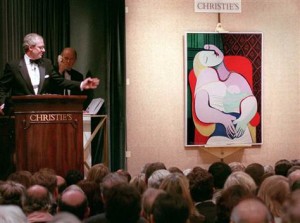
So where can all these people store all that kind of value? Real (literally) estate entails significant carrying costs. The 18th floor of the Sherry Netherlands Hotel, for instance, has been marked down $30 million to a more reasonable $95 million, but the monthly maintenance fee is $60,000. And real estate is not particularly portable, unlike paintings which you can just carry back to Russia or China on your private jet.
In a world where the top 1% of the world’s population control over 50% of the wealth, an abstraction like Art would seem like a wonderful solution. Certainly it was for the billionaire Qatari who just spent $179 million for the current record breaking Picasso. However, the merely rich, too, need something to decorate their humble seven-figure abodes and show people how rich and clever they are. This demand has resulted in an ever-increasing need for more art. Luckily Andy Warhol practically single-handedly created a new category called called Contemporary Art when he broke all the rules and put a frame around a can of soup. Suddenly, anything could be art, thus conveniently increasing its supply exponentially. Over the past decades other would-be revolutionaries have become rich and famous by putting frames around everything from chicken-scratch doodles (Cy Twombley) and comic strips (Roy Lichtenstein) to dead animals floating in tanks of formaldehyde (Damian Hirst) and West Highland white terriers (Jeff Koons).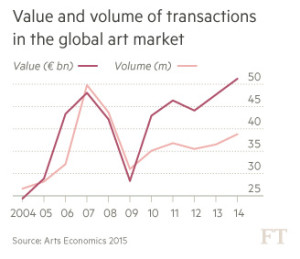
One of the lessons of history is that when governments go crazy printing money it often loses its value. Today it is not only governments who can print money, it is a small number of artists whom art dealers and the super rich have randomly anointed. Anything these artists produce magically becomes money: piles of candy, messy unmade beds, even pieces of shit. This Contemporary Art can be produced as fast as you can say “art asset investments.” However, even as supply increases, demand has begun to break down except at the highest level. Fewer and fewer people are exchanging more and more wealth for a dwindling number of these abstractions, as a graph compiled by the Financial Times clearly shows.
It is very dangerous when people lose sight of the difference between wealth and the abstractions that stand in for wealth. Natural pearls were once a formidable abstract stand-in for wealth. In 1917 the jeweler Cartier traded a double-stranded pearl necklace then worth over a million dollars for its landmark home, the Neo-Renaissance building at 53rd and Fifth Avenue. The Cartier building today is probably “worth” more than that record-breaking Picasso. The necklace was sold at auction in 1957 for $151,000.
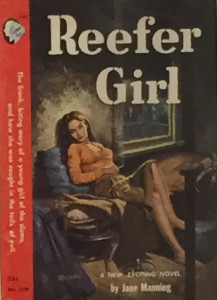 The present attitude toward art has evolved so slowly that it must seem like a totally reasonable stand-in for real wealth to the 1% (whom the other 99% believe don’t know the value of a dollar). It probably seemed just as reasonable that certain tulip bulbs were worth more than country estates in 17th Century Holland. Or that companies which never earned a nickel were “worth” more than General Electric during the Dot.com years. Art is no longer beautiful and/or meaningful creations by people with unique talent who have worked years honing their craft, it is now practically defined as rule breaking in an area that no longer has any rules. No one has put a frame around a pile of ping pong balls? Quick, call the Whitney!
The present attitude toward art has evolved so slowly that it must seem like a totally reasonable stand-in for real wealth to the 1% (whom the other 99% believe don’t know the value of a dollar). It probably seemed just as reasonable that certain tulip bulbs were worth more than country estates in 17th Century Holland. Or that companies which never earned a nickel were “worth” more than General Electric during the Dot.com years. Art is no longer beautiful and/or meaningful creations by people with unique talent who have worked years honing their craft, it is now practically defined as rule breaking in an area that no longer has any rules. No one has put a frame around a pile of ping pong balls? Quick, call the Whitney!
“Appropriation artist” Richard Prince is a just one example of what I call “Emperor’s New Clothes Art” — as in Hans Christian Andersen’s classic story. The rule Price broke was the Eighth Commandment: Thou Shalt Not Steal. For one of his early successes Prince photographed and retouched other’s people photographs. Another triumph are “his” Nurse Paintings where Prince scanned book covers, transferred the images to canvas with an inkject printer, and then added some acrylic paint. Recently he was in the news for reproducing people’s Instagram posts without notice or permission and selling them for $90,000.
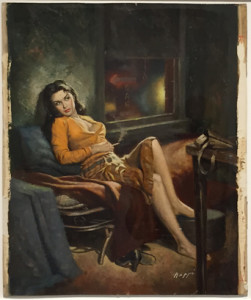 Prince is handled by the Gagosian Gallery, one of the important galleries in the world, where his oxymoronically entitled show “Original” can be seen until June 20, 2015. Over the years Prince purchased the original cover art for the pulp paperback books that he collects. Such paintings, many by unknown artists, often sell for less than $1000 and you can find vintage paperbacks on Ebay for a few bucks. For the Gagosian show Prince simply framed the paperback along with the original cover art. The result actually ends up looking pretty cool until you find out that the prices are in the $250,000 range. That’s right: people are spending $250,000 for a framing job. And I’m sure they’ll tell you that you’re an unsophisticated idiot if you don’t see how important and wonderful this latest fashion is.
Prince is handled by the Gagosian Gallery, one of the important galleries in the world, where his oxymoronically entitled show “Original” can be seen until June 20, 2015. Over the years Prince purchased the original cover art for the pulp paperback books that he collects. Such paintings, many by unknown artists, often sell for less than $1000 and you can find vintage paperbacks on Ebay for a few bucks. For the Gagosian show Prince simply framed the paperback along with the original cover art. The result actually ends up looking pretty cool until you find out that the prices are in the $250,000 range. That’s right: people are spending $250,000 for a framing job. And I’m sure they’ll tell you that you’re an unsophisticated idiot if you don’t see how important and wonderful this latest fashion is.
I’m sorry, but the Emperor has no clothes.
Bubbles end when price and value diverge overwhelmingly, though it’s always been been difficult to call a top 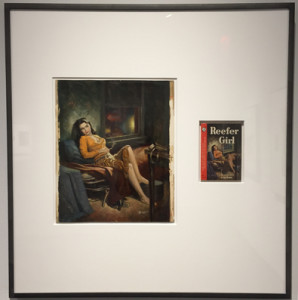 (economist John Maynard Keynes is said to have remarked that the market can remain irrational longer than you can remain solvent). There more than a few billionaires who have made their fortunes by betting on irrationality, but at some point the music stops. Today’s art market is fueled by huge amounts of international money from people who are speculating in a rigged market that what they buy today will garner them the same status (and profits) as others of their financial station have enjoyed for years.
(economist John Maynard Keynes is said to have remarked that the market can remain irrational longer than you can remain solvent). There more than a few billionaires who have made their fortunes by betting on irrationality, but at some point the music stops. Today’s art market is fueled by huge amounts of international money from people who are speculating in a rigged market that what they buy today will garner them the same status (and profits) as others of their financial station have enjoyed for years.
It will end badly.
